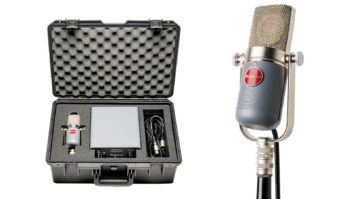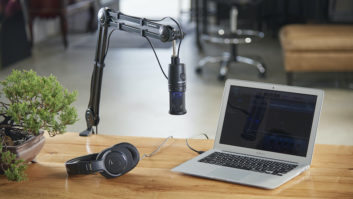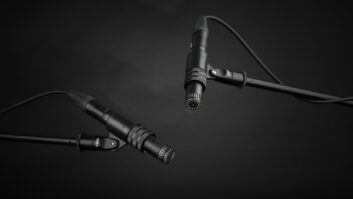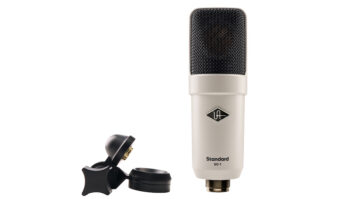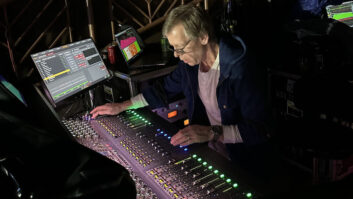Large-diaphragm condenser microphones such as the Telefunken ELAM 251, AKG C-12 and Neumann U47 are practically legendary: They captured many of the quintessential musical performances and historical moments of the 20th century. With the utmost care and near-reverence, Soundelux has painstakingly re-created new microphones based on the designs and classic sounds of some of these mics. The company’s newest release is the E47C, a cardioid-only re-creation of the short-body Neumann U47.
INSIDE STORY
The E47C is handmade in the U.S. The similarities to the U47 begin at the business end of the E47C: the metal head grille. Three layers of the same wire cloth with the same hole spacing and diameter as the original Neumann are used. Soundelux’s point here is to reproduce the “space” around the capsule without any trickery or “improvements.” The only difference between the two mics seems to be that Neumann’s screen pattern ran diagonally and Soundelux’s runs horizontally and vertically.
The E47C uses a classic K47-style capsule with a single backplane drilled in the identical hole pattern of the original. It’s a center-terminated, 1.1-inch-diameter capsule with 6-micron-thick, gold-sputtered dual-Mylar membranes and brass mounting rings.
Because most engineers have used the U47 in cardioid mode for vocals, making the E47C cardioid-only solves many problems common to the original U47. Higher power resistors cut down the amount of generated internal heat. (The E47C runs at close to room temperature.) This means you’ll have a lower noise floor, and you’ll find no noise-prone pattern switch in the E47C. Because it has a dual-membrane capsule, another advantage of the E47C is that, after years of close vocal use, you can just flip the capsule around instead of replacing it.
The E47C uses an NOS Telefunken EF814k tube situated in a shock-mounted ceramic socket. (The suffix “k” is added after selection, burn-in and testing of the tube at the Soundelux factory in Los Angeles.) The EF814 is a large plate — area pentode tube (wired as a triode) that’s very close in characteristics to the original U47’s “out of print” VF-14 tube. Soundelux located and procured a huge supply of EF814ks in Europe, so the company is well-stocked for the future.
The E47C’s output transformer follows the original U47 BV8 transformer’s construction and hybrid lamination style. It’s the same size and shape, and has identical four-section windings for good low-frequency response without loss of high frequencies.
The company’s new 110/220VAC outboard N470 linear power supply is the exact same size as the U47’s, but it is more modern and has both AC and DC mic power indicators on each end of the chassis. So from across a dark studio, you’ll always know if you’ve got power. The mic connects to the power supply with a supplied 20-foot multipin cable that uses threaded Tuchel connectors at each end. You can order a second cable and connect them together to make a 40-footer.
WORKIN’ IT
During a month of sessions, I recorded three different solo singers, a flute, a group of singers, a drum kit and an acoustic guitar with a single E47C. In all cases, I used the exact same mic placement, and the microphone was extremely true to the source.
I tried a Neumann M149 alongside the E47C on my first singer. I used Neve 1073 modules for both mics, followed by Universal Audio LA-2A leveling amps. By comparison, the M149 has a “finished mix” sound with a bold midrange character, extended high frequency and loads of output. Although it is a great mic, my soft singer sounded better on the E47C because the low-end warmth filled out her thin sound. As an unexpected benefit, during the mix and after adding EQ and compression, I had to de-ess much less (or not at all) on her vocal tracks.
My second female vocalist sang louder and more stridently. I used the same signal chain, and the E47C stood up very well for her close-mic style — much better than a vintage Neumann U47 where close vocals frequently overload. I can safely say that any overloading I heard (a kind of compressed graininess) was on extreme peaks caused by a combination of the Neve and the LA-2A and not by the mic, because backing the singer off the mic and making up the level drop with preamp gain produced the same results (though it became more roomy-sounding).
For my flute recording, I placed the E47C about one-and-a-half feet above the musician, who sat in the middle of a large room. I used 34 dB of gain from a Mercury Recording M72s tube preamp. To better fit the dense track, I added 2 dB at 9kHz shelf and 1 dB at 3kHz broad with a GML 8200 EQ. The tube mic and preamp were a good call for a large and beautiful sound that captured all of the flute’s subtleties along with the room’s spatial qualities.
When recording background singers, the cardioid pattern seemed right — not too wide so as to bring in too much room, but narrow enough for a focused sound on my singers, who were standing two or three abreast. The singers found the mic’s proximity effect wonderful to accent certain phrases or to make the more important harmony notes “pop” out of the blend.
In a home studio using a Pro Tools|HD rig, I recorded a barrel-chested male singer with a PreSonus M80 mic preamp set to about 30 dB of gain with no EQ or compression. I A/B’d to a different M149 that required only 15 dB of gain. Both mics were the same height and distance, and I recorded the same performance to two separate tracks at the same time.
The E47C had a more robust sound without the presence peak of the M149. The Neumann, in this case, sounded roomy or distant, and a little thin. The E47C sounded “gutsy” and closer. I like the different qualities of both these mics, but I would have to add a broad peak at 3 to 5 kHz to duplicate the Neumann’s forwardness. As a mixer, I like the option of adding EQ after recording vocals to best match a project’s musical and production style. During the mix, I could “twist” the tracks made with the E47C any way I wanted — everything was there.
NATURAL DRUMS AND GUITAR
I recorded an entire drum kit with the E47C and was surprised by how true the recording was to the way the kit had sounded in the room, especially considering that the single mic was four-and-a-half feet in front of the kick and about five feet off the floor. The balance was natural-sounding, with plenty of low frequencies from the kick and snare. The E47C has tremendous “reach” in that an entire range of sounds — from closest (and loudest) to most distant (and softest) — are all heard in natural perspective.
Acoustic guitar recording went well, even though I usually prefer the extra articulation that small-diaphragm condensers deliver for this task. Placing the E47C about 18 inches out front of a Martin D-28 between the soundhole and 12th fret produced a natural, full sound — excellent for rhythm playing. I used minimal compression and a very gentle highpass filter to remove room rumble and boom.
A MIC FOR MANY APPS
Many home studio owners ask me what mic they should buy for recording everything. I can confidently say that, apart from close-miking drums or loud guitar cabinets, the E47C is a great choice. Whether you’re tracking lead and backing vocals, acoustic guitar, drums or orchestral instruments, you would have a hard time duplicating the great sound of this mic at any cost.
Price: $4,250.
Soundelux Microphones, 323/464-9601, www.soundeluxmics.com.
Barry Rudolph is an L.A.-based recording engineer. Visit his Website at
www.barryrudolph.com.
